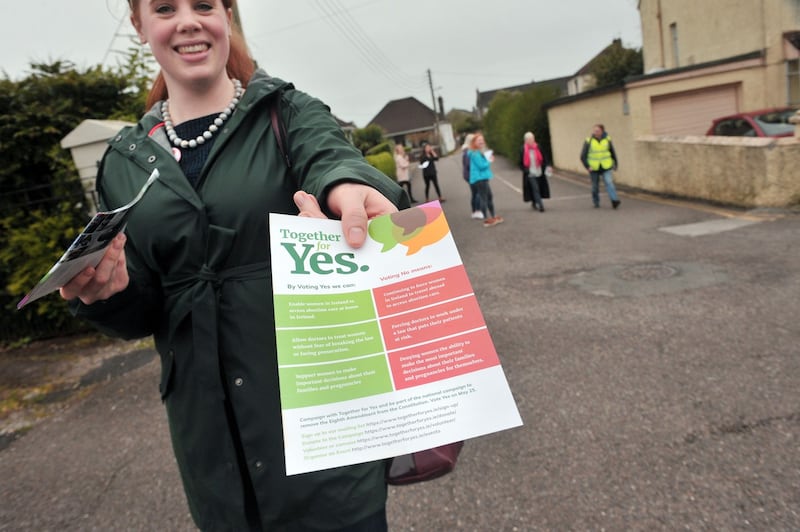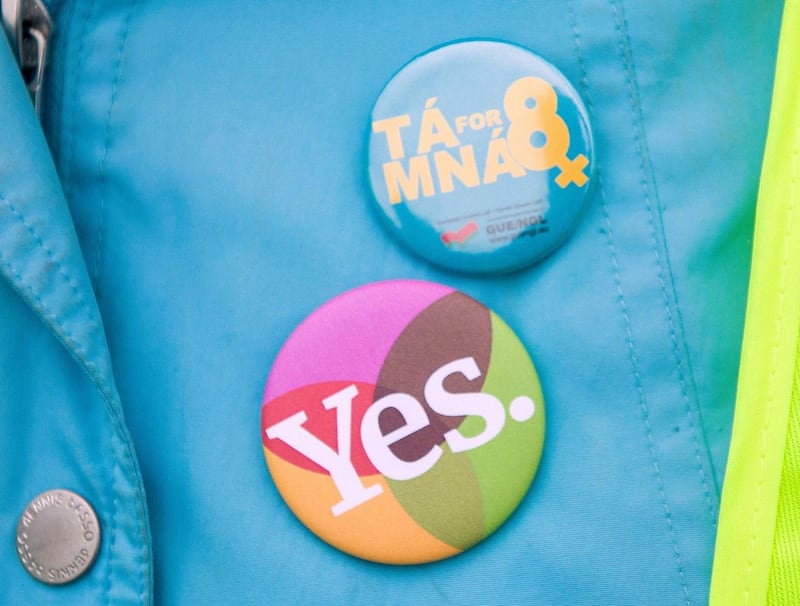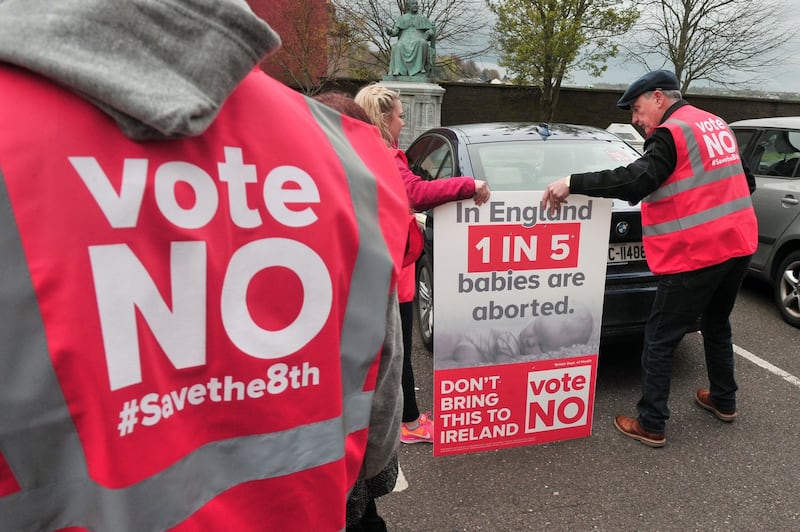When you ask Joe Walsh, a No campaigner, when he started canvassing for the referendum on the Eighth Amendment to the Constitution, his response takes you aback. “We started three years ago,” he says, matter-of-factly, “and have not stopped since then.”
Although the media spotlight over the past five years has been mostly on the evolution of the referendum to decide whether to repeal the amendment, which bans abortion in almost all circumstances, anti-abortion campaigners have not been idle, as is immediately apparent outside Dublin. The No campaign was first to put up its posters, and it has big canvassing teams, in which young women tend to be to the fore, in most parts of the State.
As we march up Cathedral Road in north Cork, Walsh, a veteran of anti-abortion campaigns, says that there are 25 canvassing groups across the city and county and that every house in the city will be canvassed at least once by polling day, on May 25th.
The young man listens intently and silently. The canvassers can't tell if they have swayed him, but they take heart that he at least listened
It’s not just a box-ticking exercise. As they move along the neat terraces of another hill on the city’s north side it is clear they are fighting for every vote. At one doorstep a woman says she is voting No; her adult son, citing rape cases, is veering towards Yes.
Walsh’s fellow Save the 8th campaigners Denis Taylor and Maria Casey spend 10 minutes explaining why they believe abortion is not a long-term solution for rape victims. “When women see the 12-week scan they say, ‘That is my baby.’ They do not say, ‘That is my foetus,’ ” Casey says.
The mother agrees and tells her son: “See, it has a heartbeat at 12 weeks, and you can see its hand.” The young man listens intently and silently. The canvassers can’t tell if they have swayed him, but they take heart that he at least listened.

The city’s Yes campaigners are equally committed, and equally willing to have long conversations in the hope of winning over waverers. Glasheen, to the south of the River Lee, is a pleasant suburb with a mix of older residents and, given its proximity to University College Cork, students.
Luke Field, an ever-optimistic postgraduate, is talking to the 20 or so mostly young campaigners whom he is leading today. He has drawn a neat map of the area, with the areas to canvass highlighted in yellow. “We are going down Glasheen Road and then left. We will work our way down towards the Lough,” he says.
Field then gives a pep talk. “The message is the same for everybody. We are here for care and compassion and for the necessary changes in Irish law that will make that happen,” he says. “Everything we talk about tonight will always come back to that. We want a more caring society. We want an Ireland where women can get care when they need it. But to do that we need change.” His fellow volunteers applaud.
Glasheen’s mix of old and young residents means it has more firmly decided Yes and No voters than elsewhere. “We read the Bible here and don’t support murder. Thank you,” an older woman says curtly to one canvassing team. Then an older man opens the door of a neat bungalow and, as if to show that the demographic divide is not that neat, tells the canvassers that his household has three Yes voters.
The demands of canvassing can be relentless. Ciara Kennedy, who volunteers for Together for Yes, arrived home exhausted this evening, and felt like flopping down on the couch, but she forced herself out to knock on more doors. “We can’t be confident or complacent for a moment, not until May 26th,” the day after polling, she says.

If Field is a force of nature, his counterpart on the No side is Becky Kealy. Upbeat and direct, the twentysomething leaves little room for doubt about the outcome of the referendum. “For years all the noise was about repeal, repeal, repeal,” she says. “But since the Government told us what they are proposing, in January, I have seen a huge shift everywhere. I think the whole 12-weeks thing, they shot themselves in the foot with that. It’s too extreme for the normal Irish person . . . I fully believe we are going to win. I did not believe it last summer, but I am totally the opposite now.”
Joe Walsh agrees: the swing in opinion polls shows the momentum is going one way, he says.
You hear a lot of criticism from No campaigners of Fianna Fáil’s leader, Micheál Martin, and Tánaiste Simon Coveney, both of whom have changed their stance on abortion in recent months. “I am disgusted with them, because they have no backbone,” Kealy says. “To be flip-flopping on an issue such as abortion, that’s fairly serious. No wonder people do not trust their politicians any more.”
All the canvassers are very polite, as are the vast majority of the householders they call on. Are voters just making the appropriate noises for whoever calls to their doors?
Both sides say they have momentum. Field’s team do a quick tally of the dozens of houses canvassed: 53 per cent yes, 27 per cent no and 20 per cent don’t know. Over at North Cathedral, however, the No canvassers have a completely contrary tally. The divergence can’t be fully explained by the areas’ different profiles, even though middle-class areas tend to have more Yes voters. Both sides can’t be right about the way their campaigns are going.
Could the similar way everyone is canvassing hold the key? Joy Cantwell-Moore, a Love Both campaigner, describes the way she and her colleagues Anna Daly and Rachel O’Riordan were trained before canvassing for a No vote in south Cork. “It was very simple, right down to how you knock on the door. You respect signs that say ‘No Junk Mail’. They teach you how to be respectful and how to centre your points, not to be going on big tangents.”
You see can the results of that training on both sides. All the canvassers are very polite, as are the vast majority of the householders they call on. Are voters just making the appropriate noises for whoever calls to their doors? A lot of people take leaflets and say they will think about it. Among the definites are big clusters of noncommittal people.
One young woman, heavily pregnant, is adamantly noncommittal. She tells No canvassers she will take their leaflet but does not want to be dictated to. “I don’t need to be fed propaganda from either side. I would say the same thing to Yes campaigners,” she says.

Both sides face some searching questions. For the No side they’re about what to do in cases of rape, incest and fatal foetal abnormalities if the referendum’s proposal to liberalise the Republic’s abortion laws is defeated. For the Yes side the questions are about the referendum’s proposal to allow terminations until the 12th week of pregnancy.
“A lot of people ask about the 12 weeks,” says Dylan O’Keeffe, a young Yes campaigner. “But once we get the answer across that, for the care and compassion we need, it has to be 12 weeks . . . people accept that. There are a lot of undecideds, and they are the key people we need to get to.”
Pamela Hickey and Michelle Harmon have just received a strong Yes from a young woman. But both are honest about the bigger picture. “It’s hard to tell. You can be in a bit of a bubble with friends and family,” Hickey says. “But we are fighting through it anyway.”
It's early days, not a time to become complacent. The hard work of people before us is paying off. People are a lot more open now and willing to speak about it
Harmon agrees. “It’s early days, not a time to become complacent,” she says. “The hard work of people before us is paying off. People are a lot more open now and willing to speak about it, even the undecideds.”
Becky Kealy, the No campaigner, sets out her side’s unwavering argument about the more difficult cases. “Fatal foetal abnormality is not a medical term. It’s a life-limiting condition, and all our lives are limited. Those babies have the right to life. Just because they have a disability does not make them less human,” she says. “As a society we presume that after rape women want abortion. That is not true. They want support and love and compassion.” Many women who are raped choose to continue with their pregnancies, she says.
It’s noticeable that few politicians are on the streets. (Donnchadh Ó Laoghaire, the Sinn Féin TD, is the only one we meet on Thursday.) The canvassing in this referendum campaign has been mostly left to activists, whose commitment and focus are unquestionable.
Opinion polls might indicate a strong lead for the Yes side, but the feedback on the doorsteps suggests that, in places like Cork, this campaign could be a closer-run thing.



















